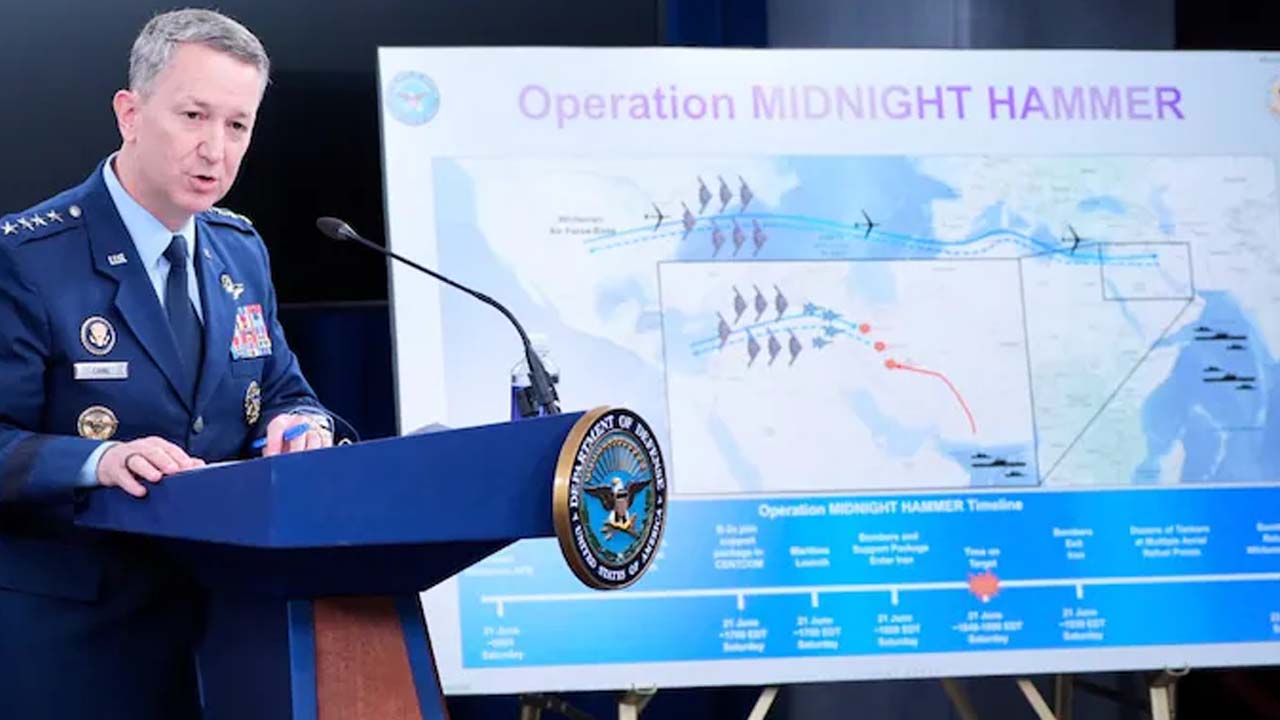In a historic military operation, the United States launched a powerful and meticulously coordinated airstrike named Operation Midnight Hammer, targeting Iran’s most sensitive nuclear facilities. The overnight strikes, ordered by President Donald Trump, hit three critical sites—Fordow, Natanz, and Isfahan—with unprecedented precision and firepower, marking a pivotal moment in US-Iran tensions.
The Strike
Operation Midnight Hammer was led by seven B-2 Spirit stealth bombers, which dropped fourteen GBU-57 Massive Ordnance Penetrators—30,000-pound bombs designed to destroy fortified underground facilities—on Fordow and Natanz. These facilities, buried deep within mountains, were central to Iran’s uranium enrichment program.
Complementing the aerial assault, US Navy submarines launched Tomahawk cruise missiles on the Isfahan site, reportedly targeting highly enriched uranium stockpiles. The entire operation mobilized over 125 aircraft, including support units like in-air refueling tankers and surveillance aircraft, making it the largest B-2 bomber deployment in US history and the second-largest globally.
Military planners executed a complex strategy of deception, sending decoy aircraft westward into the Pacific, while the real strike force flew east, evading Iranian detection systems. All aircraft returned safely, with no engagement from Iranian air defense systems, underscoring the mission’s precision and surprise.
Iran’s Reaction
Iran confirmed the strikes but sought to downplay their impact. State broadcaster official Hassan Abedini claimed key nuclear materials had already been moved. Iran’s Atomic Energy Organization condemned the operation as a “barbaric violation of international law.”
Within hours of the strikes, Iran launched missiles at Tel Aviv and Haifa, injuring over 80 people. While seen as a swift show of force, many analysts believe a more calculated Iranian retaliation is likely in the days ahead. Iran’s Foreign Minister Abbas Araqchi warned of serious consequences and accused the US of dragging the region into conflict after failing in diplomacy.
Diplomatic Collapse and Road to the Strike
Before resorting to military action, Washington made several attempts to revive diplomacy, including five rounds of talks led by US envoy Steve Witkoff. But with Iran’s nuclear program accelerating and no agreement in sight, the Pentagon prepared the surgical operation to reset the regional balance.
President Trump, addressing the nation following the strikes, warned Tehran that the US has many more targets and would not hesitate to act again. “Nuclear ambiguity is unacceptable,” he said, adding that the mission was a message to both allies and adversaries of America’s resolve.
Global Reaction and Strategic Fallout
The strike drew swift and diverse reactions. UN Secretary-General Antonio Guterres labeled it a “dangerous escalation,” while Russia blamed the US for instigating a new war. India, Saudi Arabia, and Oman called for restraint, emphasizing the need to avoid further destabilization in the Middle East.
UK Prime Minister Keir Starmer, while acknowledging the threat posed by Iran’s nuclear ambitions, stressed the need for de-escalation and diplomacy. Many experts warned that even if infrastructure is destroyed, Iran’s scientific knowledge remains, and such operations can only delay—not eliminate—nuclear capability.
What Lies Ahead
With Iran vowing retaliation and the global community bracing for the consequences, Operation Midnight Hammer could become a defining moment in the US-Iran standoff. It showcases America’s unmatched ability to project power, but also reopens questions about the limits of military deterrence in stopping nuclear proliferation.
As the world watches, all eyes are now on Tehran’s next move—and whether diplomacy can still salvage what remains of regional stability.













